Comparative Analysis of Microfinance Impact on Poverty in Bangladesh
VerifiedAdded on 2020/01/23
|26
|9512
|147
Report
AI Summary
This report conducts a comprehensive analysis of the impact of microfinance on poverty alleviation in Bangladesh, with a specific focus on comparing the outcomes for male and female beneficiaries. The study begins with an introduction to microfinance tools, including microcredit and micro-savings, highlighting their role in empowering the poor, particularly women, in developing countries. The research aims to identify the effectiveness of microfinance in reducing poverty, considering both men and women. The study reviews the historical context of microfinance in Bangladesh, initiated by Grameen Bank, and its expansion globally. The methodology includes an examination of the research philosophy, approach, strategy, and methods used for data collection and analysis, along with ethical considerations. The literature review explores the concept of microfinance, its role in poverty reduction, and the specific impact on women's empowerment. It discusses the factors influencing access to and the utilization of microfinance, and presents a comparative analysis of previous research findings. The report also addresses the contribution of the study to the theoretical understanding of microfinance's role in poverty reduction and provides recommendations for policymakers and financial institutions. This report fills a significant gap in the literature by providing a comparative analysis of the impact of microfinance on men and women in Bangladesh.

Paraphrase This Document
Need a fresh take? Get an instant paraphrase of this document with our AI Paraphraser
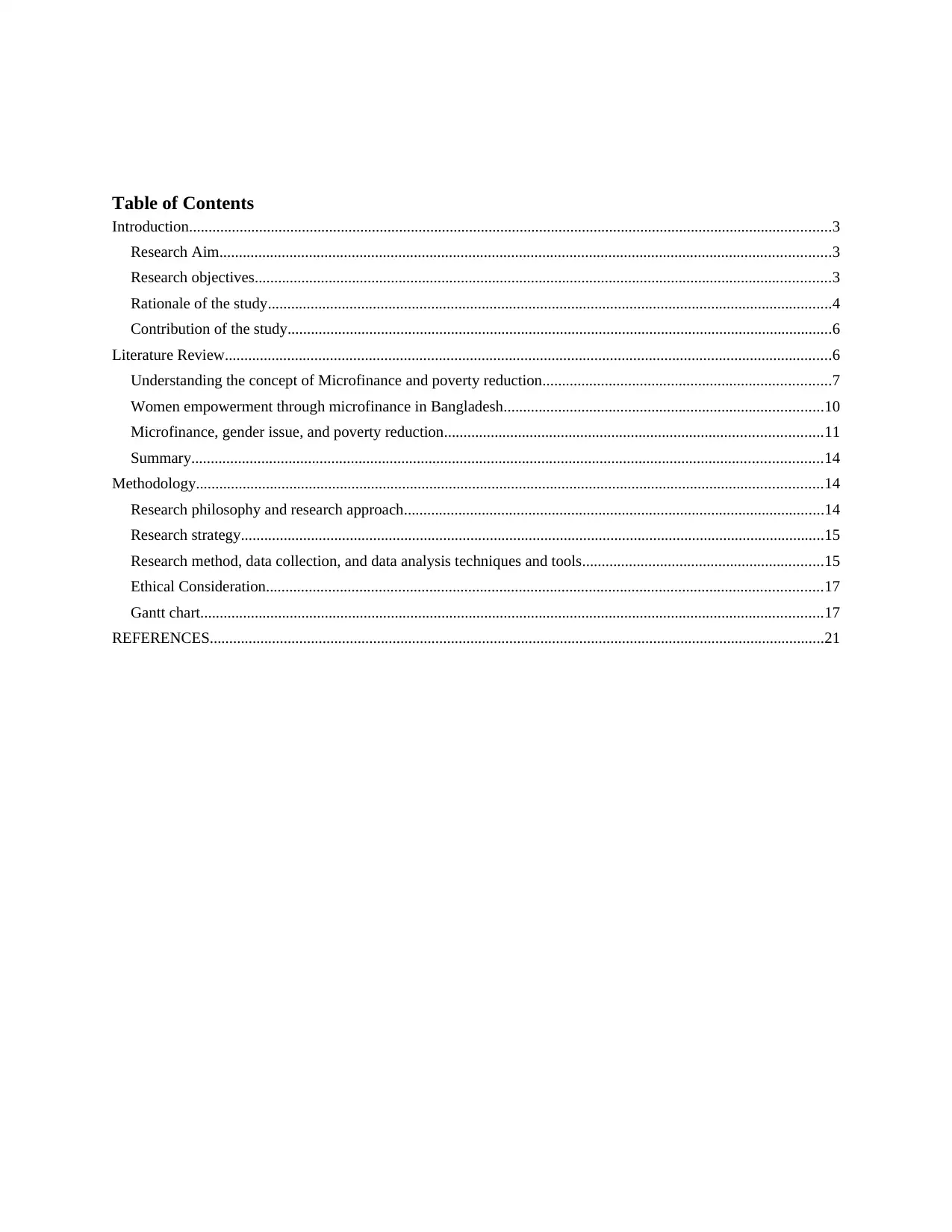
Table of Contents
Introduction.....................................................................................................................................................................3
Research Aim.............................................................................................................................................................3
Research objectives....................................................................................................................................................3
Rationale of the study.................................................................................................................................................4
Contribution of the study............................................................................................................................................6
Literature Review............................................................................................................................................................6
Understanding the concept of Microfinance and poverty reduction..........................................................................7
Women empowerment through microfinance in Bangladesh..................................................................................10
Microfinance, gender issue, and poverty reduction.................................................................................................11
Summary..................................................................................................................................................................14
Methodology.................................................................................................................................................................14
Research philosophy and research approach............................................................................................................14
Research strategy......................................................................................................................................................15
Research method, data collection, and data analysis techniques and tools..............................................................15
Ethical Consideration...............................................................................................................................................17
Gantt chart................................................................................................................................................................17
REFERENCES..............................................................................................................................................................21
Introduction.....................................................................................................................................................................3
Research Aim.............................................................................................................................................................3
Research objectives....................................................................................................................................................3
Rationale of the study.................................................................................................................................................4
Contribution of the study............................................................................................................................................6
Literature Review............................................................................................................................................................6
Understanding the concept of Microfinance and poverty reduction..........................................................................7
Women empowerment through microfinance in Bangladesh..................................................................................10
Microfinance, gender issue, and poverty reduction.................................................................................................11
Summary..................................................................................................................................................................14
Methodology.................................................................................................................................................................14
Research philosophy and research approach............................................................................................................14
Research strategy......................................................................................................................................................15
Research method, data collection, and data analysis techniques and tools..............................................................15
Ethical Consideration...............................................................................................................................................17
Gantt chart................................................................................................................................................................17
REFERENCES..............................................................................................................................................................21
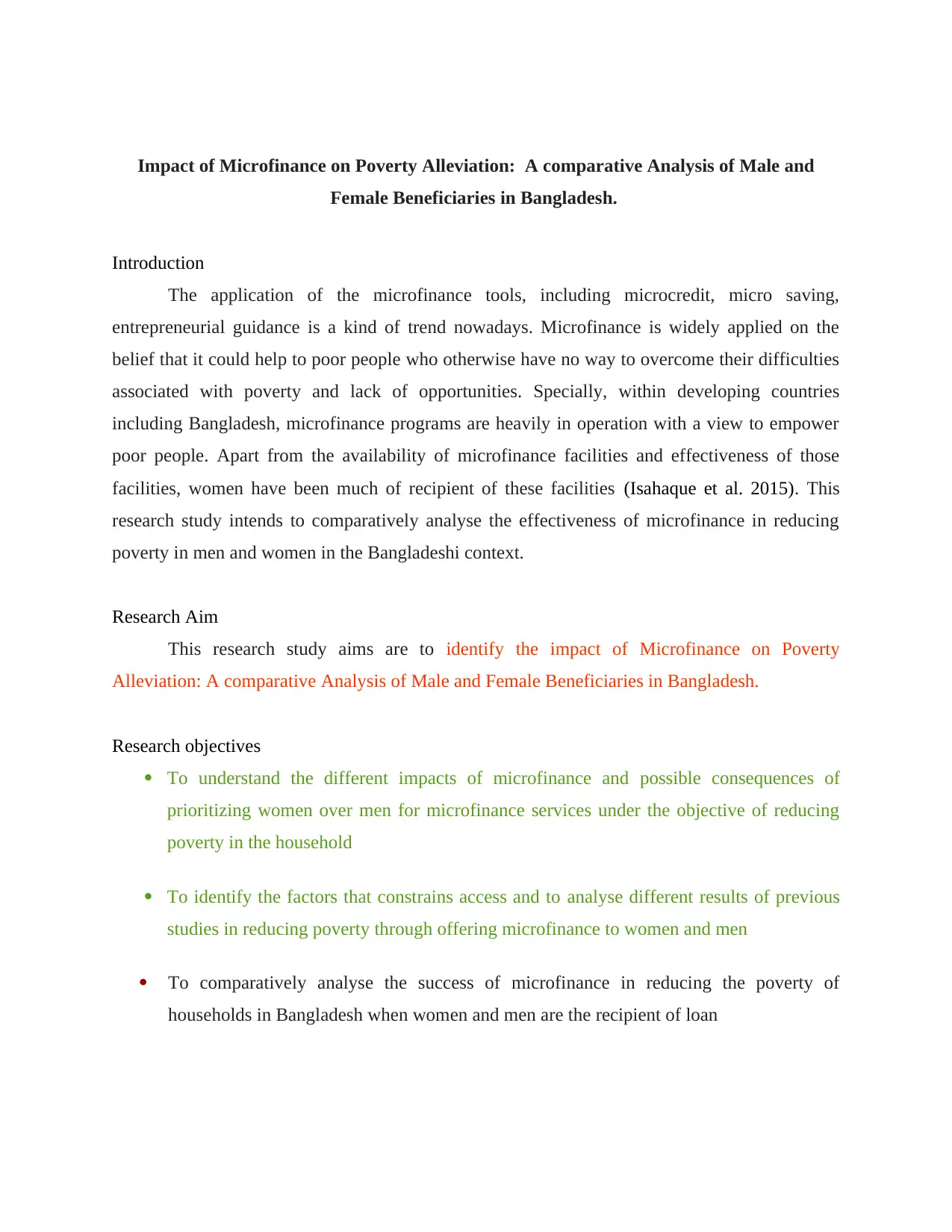
Impact of Microfinance on Poverty Alleviation: A comparative Analysis of Male and
Female Beneficiaries in Bangladesh.
Introduction
The application of the microfinance tools, including microcredit, micro saving,
entrepreneurial guidance is a kind of trend nowadays. Microfinance is widely applied on the
belief that it could help to poor people who otherwise have no way to overcome their difficulties
associated with poverty and lack of opportunities. Specially, within developing countries
including Bangladesh, microfinance programs are heavily in operation with a view to empower
poor people. Apart from the availability of microfinance facilities and effectiveness of those
facilities, women have been much of recipient of these facilities (Isahaque et al. 2015). This
research study intends to comparatively analyse the effectiveness of microfinance in reducing
poverty in men and women in the Bangladeshi context.
Research Aim
This research study aims are to identify the impact of Microfinance on Poverty
Alleviation: A comparative Analysis of Male and Female Beneficiaries in Bangladesh.
Research objectives
To understand the different impacts of microfinance and possible consequences of
prioritizing women over men for microfinance services under the objective of reducing
poverty in the household
To identify the factors that constrains access and to analyse different results of previous
studies in reducing poverty through offering microfinance to women and men
To comparatively analyse the success of microfinance in reducing the poverty of
households in Bangladesh when women and men are the recipient of loan
Female Beneficiaries in Bangladesh.
Introduction
The application of the microfinance tools, including microcredit, micro saving,
entrepreneurial guidance is a kind of trend nowadays. Microfinance is widely applied on the
belief that it could help to poor people who otherwise have no way to overcome their difficulties
associated with poverty and lack of opportunities. Specially, within developing countries
including Bangladesh, microfinance programs are heavily in operation with a view to empower
poor people. Apart from the availability of microfinance facilities and effectiveness of those
facilities, women have been much of recipient of these facilities (Isahaque et al. 2015). This
research study intends to comparatively analyse the effectiveness of microfinance in reducing
poverty in men and women in the Bangladeshi context.
Research Aim
This research study aims are to identify the impact of Microfinance on Poverty
Alleviation: A comparative Analysis of Male and Female Beneficiaries in Bangladesh.
Research objectives
To understand the different impacts of microfinance and possible consequences of
prioritizing women over men for microfinance services under the objective of reducing
poverty in the household
To identify the factors that constrains access and to analyse different results of previous
studies in reducing poverty through offering microfinance to women and men
To comparatively analyse the success of microfinance in reducing the poverty of
households in Bangladesh when women and men are the recipient of loan
⊘ This is a preview!⊘
Do you want full access?
Subscribe today to unlock all pages.

Trusted by 1+ million students worldwide

To suggest recommendations to policy makers so that the rate of poverty in Bangladesh
can be reduced.
Rationale of the study
The concept of microfinance was emerged in Bangladesh as a way of helping the poor to
stand on their feet until they establish a strong foundation in the sense of access to financial and
related services. The Grameen Bank brought the concept into practical application in Bangladesh
as per the guidance of Muhammad Yunus in 1970s. However, the microfinance concept could be
traced to back to 1800s, Grameen Banks’s initiatives led to the modern developments of the
concept and related applications. With the unique and extraordinary characteristics of the
financing concept and the relevance of the applicability in the Bangladeshi context, the
microfinance services were started to expand over the country and over the world as well
(Khandker, 1999). The contribution of the microfinance in alleviating the poverty was
emphasized from its initial work plan. The interest rates are high but it is easy for the individuals
to pay back when it is returned in installments (Roodman, 2011). On the other hand, it becomes
difficult for the individuals to pay back the amount when it has to be returned altogether. Then,
it could be reasonably expected that this financing system was well-established within the
Bangladesh due to the poor economic conditions prevailed in the country as a whole and the
deteriorated living conditions of the individuals. But, the concept was not limited to Bangladesh
or other developing countries such as Pakistan, Vietnam, etc. Also, the system was effectively
applied in many of the developed countries such as the UK and the USA (Bruton and Khavul,
2011).
The microfinance could be identified as a broad set of financial services including credit
facilities, savings, insurance, advisory, entrepreneurship guidance, etc. However, the microcredit
could be recognized as the most prominent aspect of the microfinance. The other many of the
related aspects under microfinance services are cantered by the microcredit facilities. More
importantly, in the case of alleviation or eradicating the poverty, the microcredit facilities are
immense of helpful as it provides the required capital to small entrepreneurs who would
otherwise be in difficult find them (Kabeer, 2005).
Usually, the microcredit facilities that centred the microfinance services would be provided to
individuals who are from the poor families. The application for the microfinance facilities would
can be reduced.
Rationale of the study
The concept of microfinance was emerged in Bangladesh as a way of helping the poor to
stand on their feet until they establish a strong foundation in the sense of access to financial and
related services. The Grameen Bank brought the concept into practical application in Bangladesh
as per the guidance of Muhammad Yunus in 1970s. However, the microfinance concept could be
traced to back to 1800s, Grameen Banks’s initiatives led to the modern developments of the
concept and related applications. With the unique and extraordinary characteristics of the
financing concept and the relevance of the applicability in the Bangladeshi context, the
microfinance services were started to expand over the country and over the world as well
(Khandker, 1999). The contribution of the microfinance in alleviating the poverty was
emphasized from its initial work plan. The interest rates are high but it is easy for the individuals
to pay back when it is returned in installments (Roodman, 2011). On the other hand, it becomes
difficult for the individuals to pay back the amount when it has to be returned altogether. Then,
it could be reasonably expected that this financing system was well-established within the
Bangladesh due to the poor economic conditions prevailed in the country as a whole and the
deteriorated living conditions of the individuals. But, the concept was not limited to Bangladesh
or other developing countries such as Pakistan, Vietnam, etc. Also, the system was effectively
applied in many of the developed countries such as the UK and the USA (Bruton and Khavul,
2011).
The microfinance could be identified as a broad set of financial services including credit
facilities, savings, insurance, advisory, entrepreneurship guidance, etc. However, the microcredit
could be recognized as the most prominent aspect of the microfinance. The other many of the
related aspects under microfinance services are cantered by the microcredit facilities. More
importantly, in the case of alleviation or eradicating the poverty, the microcredit facilities are
immense of helpful as it provides the required capital to small entrepreneurs who would
otherwise be in difficult find them (Kabeer, 2005).
Usually, the microcredit facilities that centred the microfinance services would be provided to
individuals who are from the poor families. The application for the microfinance facilities would
Paraphrase This Document
Need a fresh take? Get an instant paraphrase of this document with our AI Paraphraser
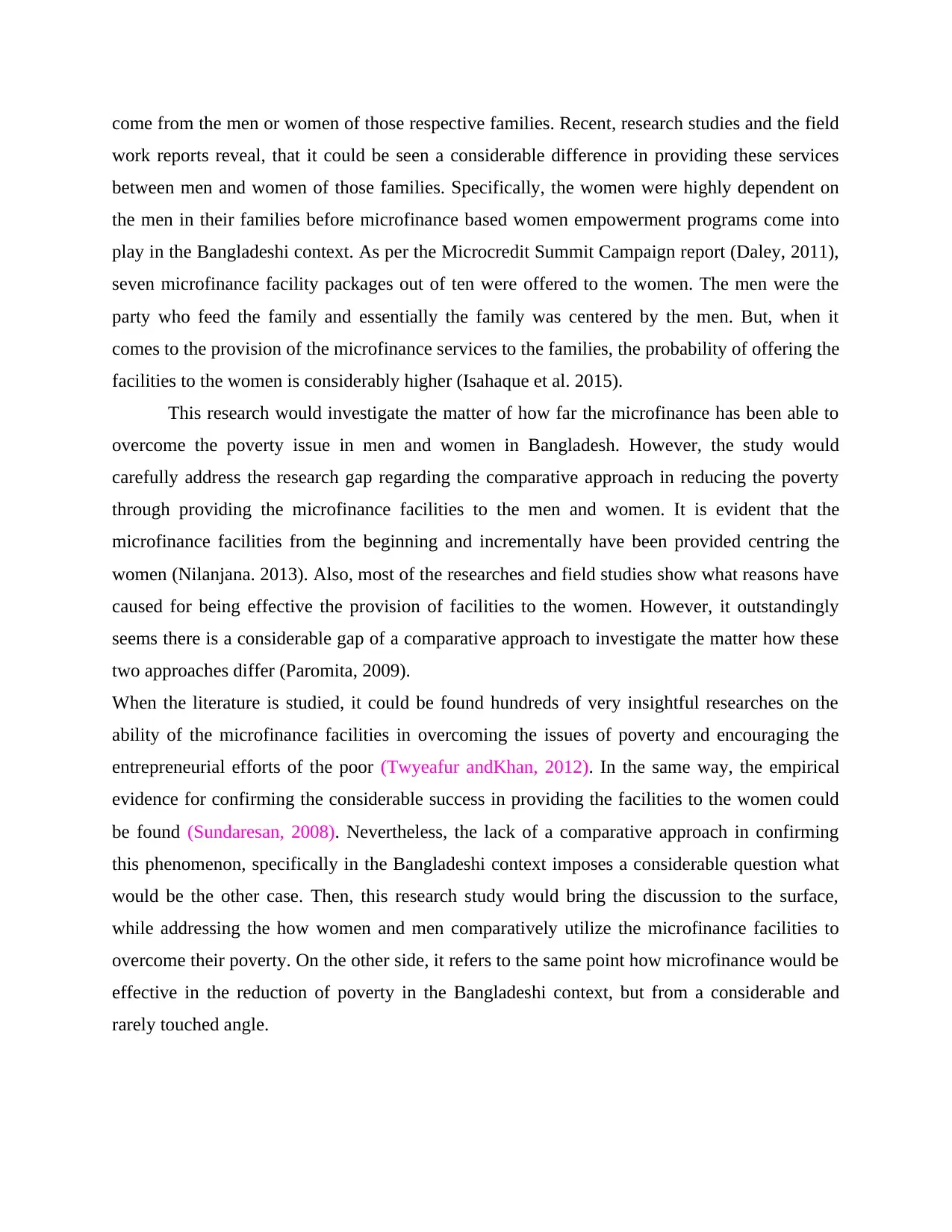
come from the men or women of those respective families. Recent, research studies and the field
work reports reveal, that it could be seen a considerable difference in providing these services
between men and women of those families. Specifically, the women were highly dependent on
the men in their families before microfinance based women empowerment programs come into
play in the Bangladeshi context. As per the Microcredit Summit Campaign report (Daley, 2011),
seven microfinance facility packages out of ten were offered to the women. The men were the
party who feed the family and essentially the family was centered by the men. But, when it
comes to the provision of the microfinance services to the families, the probability of offering the
facilities to the women is considerably higher (Isahaque et al. 2015).
This research would investigate the matter of how far the microfinance has been able to
overcome the poverty issue in men and women in Bangladesh. However, the study would
carefully address the research gap regarding the comparative approach in reducing the poverty
through providing the microfinance facilities to the men and women. It is evident that the
microfinance facilities from the beginning and incrementally have been provided centring the
women (Nilanjana. 2013). Also, most of the researches and field studies show what reasons have
caused for being effective the provision of facilities to the women. However, it outstandingly
seems there is a considerable gap of a comparative approach to investigate the matter how these
two approaches differ (Paromita, 2009).
When the literature is studied, it could be found hundreds of very insightful researches on the
ability of the microfinance facilities in overcoming the issues of poverty and encouraging the
entrepreneurial efforts of the poor (Twyeafur andKhan, 2012). In the same way, the empirical
evidence for confirming the considerable success in providing the facilities to the women could
be found (Sundaresan, 2008). Nevertheless, the lack of a comparative approach in confirming
this phenomenon, specifically in the Bangladeshi context imposes a considerable question what
would be the other case. Then, this research study would bring the discussion to the surface,
while addressing the how women and men comparatively utilize the microfinance facilities to
overcome their poverty. On the other side, it refers to the same point how microfinance would be
effective in the reduction of poverty in the Bangladeshi context, but from a considerable and
rarely touched angle.
work reports reveal, that it could be seen a considerable difference in providing these services
between men and women of those families. Specifically, the women were highly dependent on
the men in their families before microfinance based women empowerment programs come into
play in the Bangladeshi context. As per the Microcredit Summit Campaign report (Daley, 2011),
seven microfinance facility packages out of ten were offered to the women. The men were the
party who feed the family and essentially the family was centered by the men. But, when it
comes to the provision of the microfinance services to the families, the probability of offering the
facilities to the women is considerably higher (Isahaque et al. 2015).
This research would investigate the matter of how far the microfinance has been able to
overcome the poverty issue in men and women in Bangladesh. However, the study would
carefully address the research gap regarding the comparative approach in reducing the poverty
through providing the microfinance facilities to the men and women. It is evident that the
microfinance facilities from the beginning and incrementally have been provided centring the
women (Nilanjana. 2013). Also, most of the researches and field studies show what reasons have
caused for being effective the provision of facilities to the women. However, it outstandingly
seems there is a considerable gap of a comparative approach to investigate the matter how these
two approaches differ (Paromita, 2009).
When the literature is studied, it could be found hundreds of very insightful researches on the
ability of the microfinance facilities in overcoming the issues of poverty and encouraging the
entrepreneurial efforts of the poor (Twyeafur andKhan, 2012). In the same way, the empirical
evidence for confirming the considerable success in providing the facilities to the women could
be found (Sundaresan, 2008). Nevertheless, the lack of a comparative approach in confirming
this phenomenon, specifically in the Bangladeshi context imposes a considerable question what
would be the other case. Then, this research study would bring the discussion to the surface,
while addressing the how women and men comparatively utilize the microfinance facilities to
overcome their poverty. On the other side, it refers to the same point how microfinance would be
effective in the reduction of poverty in the Bangladeshi context, but from a considerable and
rarely touched angle.
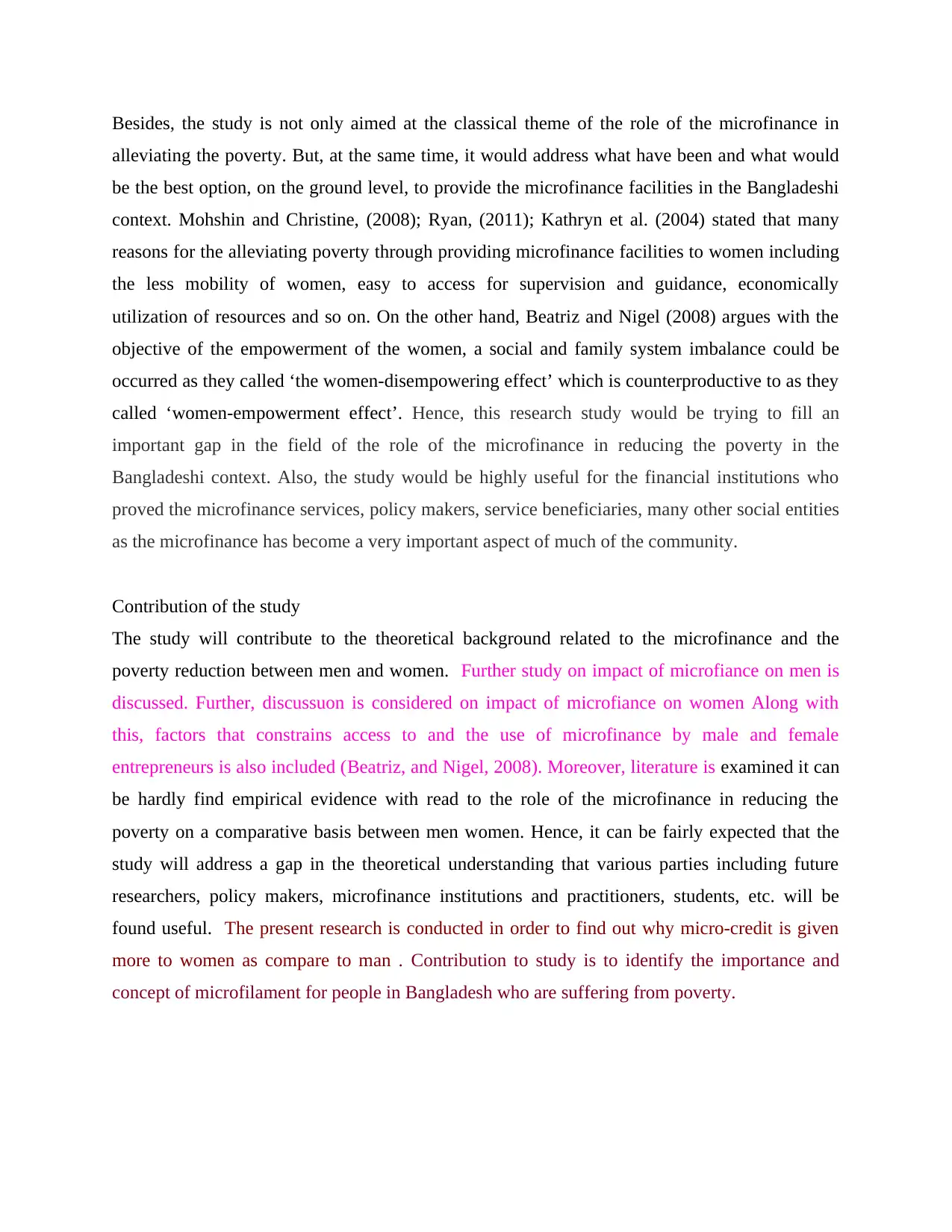
Besides, the study is not only aimed at the classical theme of the role of the microfinance in
alleviating the poverty. But, at the same time, it would address what have been and what would
be the best option, on the ground level, to provide the microfinance facilities in the Bangladeshi
context. Mohshin and Christine, (2008); Ryan, (2011); Kathryn et al. (2004) stated that many
reasons for the alleviating poverty through providing microfinance facilities to women including
the less mobility of women, easy to access for supervision and guidance, economically
utilization of resources and so on. On the other hand, Beatriz and Nigel (2008) argues with the
objective of the empowerment of the women, a social and family system imbalance could be
occurred as they called ‘the women-disempowering effect’ which is counterproductive to as they
called ‘women-empowerment effect’. Hence, this research study would be trying to fill an
important gap in the field of the role of the microfinance in reducing the poverty in the
Bangladeshi context. Also, the study would be highly useful for the financial institutions who
proved the microfinance services, policy makers, service beneficiaries, many other social entities
as the microfinance has become a very important aspect of much of the community.
Contribution of the study
The study will contribute to the theoretical background related to the microfinance and the
poverty reduction between men and women. Further study on impact of microfiance on men is
discussed. Further, discussuon is considered on impact of microfiance on women Along with
this, factors that constrains access to and the use of microfinance by male and female
entrepreneurs is also included (Beatriz, and Nigel, 2008). Moreover, literature is examined it can
be hardly find empirical evidence with read to the role of the microfinance in reducing the
poverty on a comparative basis between men women. Hence, it can be fairly expected that the
study will address a gap in the theoretical understanding that various parties including future
researchers, policy makers, microfinance institutions and practitioners, students, etc. will be
found useful. The present research is conducted in order to find out why micro-credit is given
more to women as compare to man . Contribution to study is to identify the importance and
concept of microfilament for people in Bangladesh who are suffering from poverty.
alleviating the poverty. But, at the same time, it would address what have been and what would
be the best option, on the ground level, to provide the microfinance facilities in the Bangladeshi
context. Mohshin and Christine, (2008); Ryan, (2011); Kathryn et al. (2004) stated that many
reasons for the alleviating poverty through providing microfinance facilities to women including
the less mobility of women, easy to access for supervision and guidance, economically
utilization of resources and so on. On the other hand, Beatriz and Nigel (2008) argues with the
objective of the empowerment of the women, a social and family system imbalance could be
occurred as they called ‘the women-disempowering effect’ which is counterproductive to as they
called ‘women-empowerment effect’. Hence, this research study would be trying to fill an
important gap in the field of the role of the microfinance in reducing the poverty in the
Bangladeshi context. Also, the study would be highly useful for the financial institutions who
proved the microfinance services, policy makers, service beneficiaries, many other social entities
as the microfinance has become a very important aspect of much of the community.
Contribution of the study
The study will contribute to the theoretical background related to the microfinance and the
poverty reduction between men and women. Further study on impact of microfiance on men is
discussed. Further, discussuon is considered on impact of microfiance on women Along with
this, factors that constrains access to and the use of microfinance by male and female
entrepreneurs is also included (Beatriz, and Nigel, 2008). Moreover, literature is examined it can
be hardly find empirical evidence with read to the role of the microfinance in reducing the
poverty on a comparative basis between men women. Hence, it can be fairly expected that the
study will address a gap in the theoretical understanding that various parties including future
researchers, policy makers, microfinance institutions and practitioners, students, etc. will be
found useful. The present research is conducted in order to find out why micro-credit is given
more to women as compare to man . Contribution to study is to identify the importance and
concept of microfilament for people in Bangladesh who are suffering from poverty.
⊘ This is a preview!⊘
Do you want full access?
Subscribe today to unlock all pages.

Trusted by 1+ million students worldwide

Literature Review
Understanding the concept of Microfinance and poverty reduction
Microfinance can be determined as the array of financial services. In this context, it
includes insurance, loans and saving that are make available to small business owners and poor
entrepreneurs. Further it is an instrument and a tool hold power to collectively address poverty
and provide power to socially poor people and focus on gender issues for strengthen the society.
It is also come forth as a powerful mechanism which makes sure the economic and social
empowerment of poor. According to the Subhabrata and Laurel, (2016). microfinance is the
action of providing of financial services, credit facility to poor household who do not any source
of earning and not have any access to formal financial institution. Further Kristin, Lynn and
Kathryn, (2015) defined microfinace is the source of thrift, different financial services and other
credit services of small amount to the poor people who lived in rural, semi urban areas so that
their standard of living can be improved and their income level can be enhanced. These all
financial services as per accordance to the Bert Marek, and Ariane, (2016) are covers loan,
deposit and insurance to poor, their small enterprises and money transfer. However, it is
criticized that microfinance is mainly refer to offer financial services to those people who have
zero income or do not have any source of income. The main aim of providing financial services
to poor people is to create social value. Further it provides opportunity to people to come out
from poverty so that their future risk can be avoided.
By the time of early 1980s, the extreme poverty around the world was a cancer. Chen and
Ravallion (2008) reveal that 1.4 billion people around the world experiences an income of $1 per
day. It is hard to imagine what these people eat and even it is possible to save any penny.
Specially, However, empirical evidence shows how this extreme poverty was reduced from 1981
to 2005 with the some of the global initiatives towards alleviating the poverty (Kirsten, 2012). In
this context, Muhammad Yunus in the 1970s started the Grameen Bank with the primary
objective of supporting the poor people to get rid of the poverty which would have otherwise
impossible. Yunus (1999) mentioned it could be clearly recognized the failure of the formal
financial institutions and government agencies to support the poor, as they had already been
classified as poor credit quality holders. Hence, he wanted to launch a mission to empower the
Understanding the concept of Microfinance and poverty reduction
Microfinance can be determined as the array of financial services. In this context, it
includes insurance, loans and saving that are make available to small business owners and poor
entrepreneurs. Further it is an instrument and a tool hold power to collectively address poverty
and provide power to socially poor people and focus on gender issues for strengthen the society.
It is also come forth as a powerful mechanism which makes sure the economic and social
empowerment of poor. According to the Subhabrata and Laurel, (2016). microfinance is the
action of providing of financial services, credit facility to poor household who do not any source
of earning and not have any access to formal financial institution. Further Kristin, Lynn and
Kathryn, (2015) defined microfinace is the source of thrift, different financial services and other
credit services of small amount to the poor people who lived in rural, semi urban areas so that
their standard of living can be improved and their income level can be enhanced. These all
financial services as per accordance to the Bert Marek, and Ariane, (2016) are covers loan,
deposit and insurance to poor, their small enterprises and money transfer. However, it is
criticized that microfinance is mainly refer to offer financial services to those people who have
zero income or do not have any source of income. The main aim of providing financial services
to poor people is to create social value. Further it provides opportunity to people to come out
from poverty so that their future risk can be avoided.
By the time of early 1980s, the extreme poverty around the world was a cancer. Chen and
Ravallion (2008) reveal that 1.4 billion people around the world experiences an income of $1 per
day. It is hard to imagine what these people eat and even it is possible to save any penny.
Specially, However, empirical evidence shows how this extreme poverty was reduced from 1981
to 2005 with the some of the global initiatives towards alleviating the poverty (Kirsten, 2012). In
this context, Muhammad Yunus in the 1970s started the Grameen Bank with the primary
objective of supporting the poor people to get rid of the poverty which would have otherwise
impossible. Yunus (1999) mentioned it could be clearly recognized the failure of the formal
financial institutions and government agencies to support the poor, as they had already been
classified as poor credit quality holders. Hence, he wanted to launch a mission to empower the
Paraphrase This Document
Need a fresh take? Get an instant paraphrase of this document with our AI Paraphraser
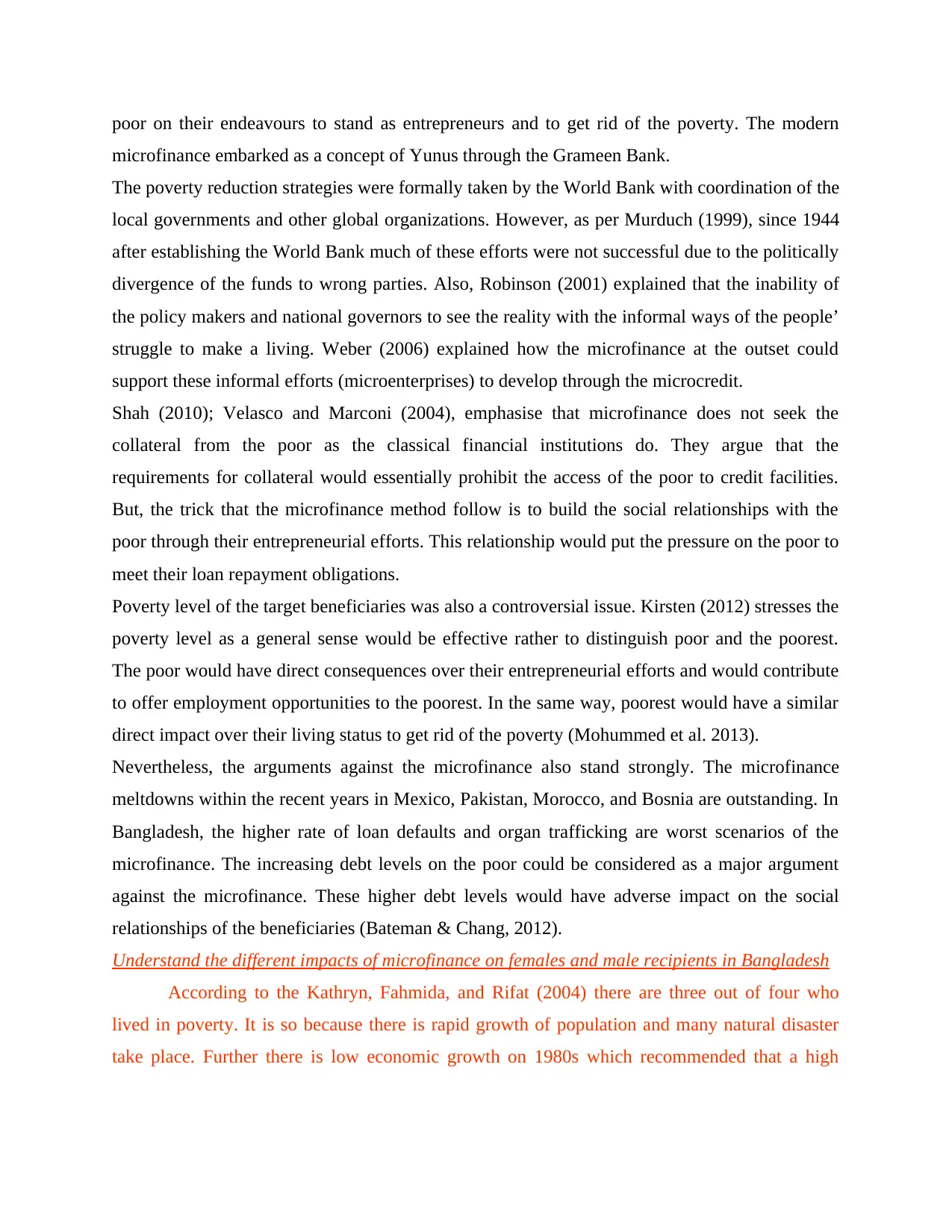
poor on their endeavours to stand as entrepreneurs and to get rid of the poverty. The modern
microfinance embarked as a concept of Yunus through the Grameen Bank.
The poverty reduction strategies were formally taken by the World Bank with coordination of the
local governments and other global organizations. However, as per Murduch (1999), since 1944
after establishing the World Bank much of these efforts were not successful due to the politically
divergence of the funds to wrong parties. Also, Robinson (2001) explained that the inability of
the policy makers and national governors to see the reality with the informal ways of the people’
struggle to make a living. Weber (2006) explained how the microfinance at the outset could
support these informal efforts (microenterprises) to develop through the microcredit.
Shah (2010); Velasco and Marconi (2004), emphasise that microfinance does not seek the
collateral from the poor as the classical financial institutions do. They argue that the
requirements for collateral would essentially prohibit the access of the poor to credit facilities.
But, the trick that the microfinance method follow is to build the social relationships with the
poor through their entrepreneurial efforts. This relationship would put the pressure on the poor to
meet their loan repayment obligations.
Poverty level of the target beneficiaries was also a controversial issue. Kirsten (2012) stresses the
poverty level as a general sense would be effective rather to distinguish poor and the poorest.
The poor would have direct consequences over their entrepreneurial efforts and would contribute
to offer employment opportunities to the poorest. In the same way, poorest would have a similar
direct impact over their living status to get rid of the poverty (Mohummed et al. 2013).
Nevertheless, the arguments against the microfinance also stand strongly. The microfinance
meltdowns within the recent years in Mexico, Pakistan, Morocco, and Bosnia are outstanding. In
Bangladesh, the higher rate of loan defaults and organ trafficking are worst scenarios of the
microfinance. The increasing debt levels on the poor could be considered as a major argument
against the microfinance. These higher debt levels would have adverse impact on the social
relationships of the beneficiaries (Bateman & Chang, 2012).
Understand the different impacts of microfinance on females and male recipients in Bangladesh
According to the Kathryn, Fahmida, and Rifat (2004) there are three out of four who
lived in poverty. It is so because there is rapid growth of population and many natural disaster
take place. Further there is low economic growth on 1980s which recommended that a high
microfinance embarked as a concept of Yunus through the Grameen Bank.
The poverty reduction strategies were formally taken by the World Bank with coordination of the
local governments and other global organizations. However, as per Murduch (1999), since 1944
after establishing the World Bank much of these efforts were not successful due to the politically
divergence of the funds to wrong parties. Also, Robinson (2001) explained that the inability of
the policy makers and national governors to see the reality with the informal ways of the people’
struggle to make a living. Weber (2006) explained how the microfinance at the outset could
support these informal efforts (microenterprises) to develop through the microcredit.
Shah (2010); Velasco and Marconi (2004), emphasise that microfinance does not seek the
collateral from the poor as the classical financial institutions do. They argue that the
requirements for collateral would essentially prohibit the access of the poor to credit facilities.
But, the trick that the microfinance method follow is to build the social relationships with the
poor through their entrepreneurial efforts. This relationship would put the pressure on the poor to
meet their loan repayment obligations.
Poverty level of the target beneficiaries was also a controversial issue. Kirsten (2012) stresses the
poverty level as a general sense would be effective rather to distinguish poor and the poorest.
The poor would have direct consequences over their entrepreneurial efforts and would contribute
to offer employment opportunities to the poorest. In the same way, poorest would have a similar
direct impact over their living status to get rid of the poverty (Mohummed et al. 2013).
Nevertheless, the arguments against the microfinance also stand strongly. The microfinance
meltdowns within the recent years in Mexico, Pakistan, Morocco, and Bosnia are outstanding. In
Bangladesh, the higher rate of loan defaults and organ trafficking are worst scenarios of the
microfinance. The increasing debt levels on the poor could be considered as a major argument
against the microfinance. These higher debt levels would have adverse impact on the social
relationships of the beneficiaries (Bateman & Chang, 2012).
Understand the different impacts of microfinance on females and male recipients in Bangladesh
According to the Kathryn, Fahmida, and Rifat (2004) there are three out of four who
lived in poverty. It is so because there is rapid growth of population and many natural disaster
take place. Further there is low economic growth on 1980s which recommended that a high
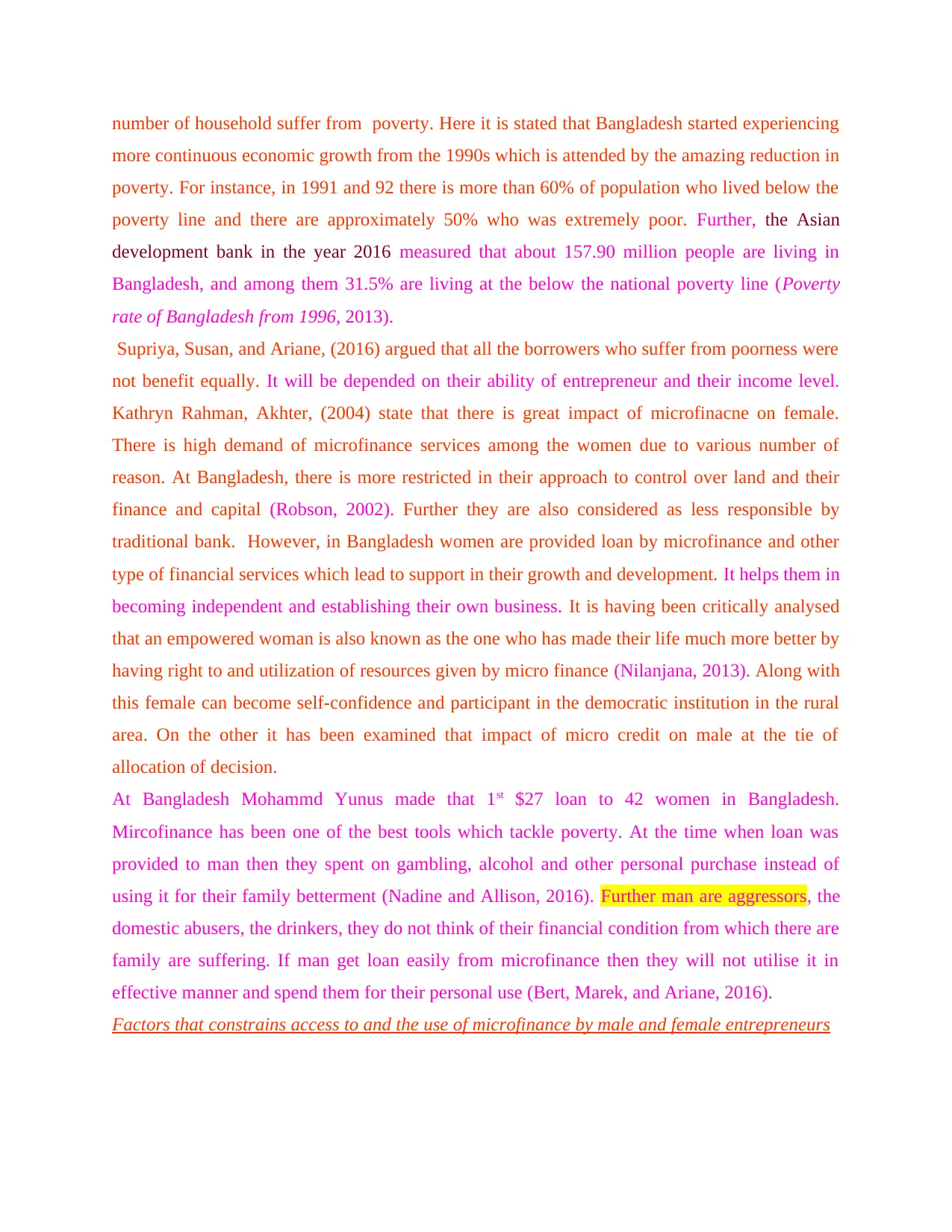
number of household suffer from poverty. Here it is stated that Bangladesh started experiencing
more continuous economic growth from the 1990s which is attended by the amazing reduction in
poverty. For instance, in 1991 and 92 there is more than 60% of population who lived below the
poverty line and there are approximately 50% who was extremely poor. Further, the Asian
development bank in the year 2016 measured that about 157.90 million people are living in
Bangladesh, and among them 31.5% are living at the below the national poverty line (Poverty
rate of Bangladesh from 1996, 2013).
Supriya, Susan, and Ariane, (2016) argued that all the borrowers who suffer from poorness were
not benefit equally. It will be depended on their ability of entrepreneur and their income level.
Kathryn Rahman, Akhter, (2004) state that there is great impact of microfinacne on female.
There is high demand of microfinance services among the women due to various number of
reason. At Bangladesh, there is more restricted in their approach to control over land and their
finance and capital (Robson, 2002). Further they are also considered as less responsible by
traditional bank. However, in Bangladesh women are provided loan by microfinance and other
type of financial services which lead to support in their growth and development. It helps them in
becoming independent and establishing their own business. It is having been critically analysed
that an empowered woman is also known as the one who has made their life much more better by
having right to and utilization of resources given by micro finance (Nilanjana, 2013). Along with
this female can become self-confidence and participant in the democratic institution in the rural
area. On the other it has been examined that impact of micro credit on male at the tie of
allocation of decision.
At Bangladesh Mohammd Yunus made that 1st $27 loan to 42 women in Bangladesh.
Mircofinance has been one of the best tools which tackle poverty. At the time when loan was
provided to man then they spent on gambling, alcohol and other personal purchase instead of
using it for their family betterment (Nadine and Allison, 2016). Further man are aggressors, the
domestic abusers, the drinkers, they do not think of their financial condition from which there are
family are suffering. If man get loan easily from microfinance then they will not utilise it in
effective manner and spend them for their personal use (Bert, Marek, and Ariane, 2016).
Factors that constrains access to and the use of microfinance by male and female entrepreneurs
more continuous economic growth from the 1990s which is attended by the amazing reduction in
poverty. For instance, in 1991 and 92 there is more than 60% of population who lived below the
poverty line and there are approximately 50% who was extremely poor. Further, the Asian
development bank in the year 2016 measured that about 157.90 million people are living in
Bangladesh, and among them 31.5% are living at the below the national poverty line (Poverty
rate of Bangladesh from 1996, 2013).
Supriya, Susan, and Ariane, (2016) argued that all the borrowers who suffer from poorness were
not benefit equally. It will be depended on their ability of entrepreneur and their income level.
Kathryn Rahman, Akhter, (2004) state that there is great impact of microfinacne on female.
There is high demand of microfinance services among the women due to various number of
reason. At Bangladesh, there is more restricted in their approach to control over land and their
finance and capital (Robson, 2002). Further they are also considered as less responsible by
traditional bank. However, in Bangladesh women are provided loan by microfinance and other
type of financial services which lead to support in their growth and development. It helps them in
becoming independent and establishing their own business. It is having been critically analysed
that an empowered woman is also known as the one who has made their life much more better by
having right to and utilization of resources given by micro finance (Nilanjana, 2013). Along with
this female can become self-confidence and participant in the democratic institution in the rural
area. On the other it has been examined that impact of micro credit on male at the tie of
allocation of decision.
At Bangladesh Mohammd Yunus made that 1st $27 loan to 42 women in Bangladesh.
Mircofinance has been one of the best tools which tackle poverty. At the time when loan was
provided to man then they spent on gambling, alcohol and other personal purchase instead of
using it for their family betterment (Nadine and Allison, 2016). Further man are aggressors, the
domestic abusers, the drinkers, they do not think of their financial condition from which there are
family are suffering. If man get loan easily from microfinance then they will not utilise it in
effective manner and spend them for their personal use (Bert, Marek, and Ariane, 2016).
Factors that constrains access to and the use of microfinance by male and female entrepreneurs
⊘ This is a preview!⊘
Do you want full access?
Subscribe today to unlock all pages.

Trusted by 1+ million students worldwide
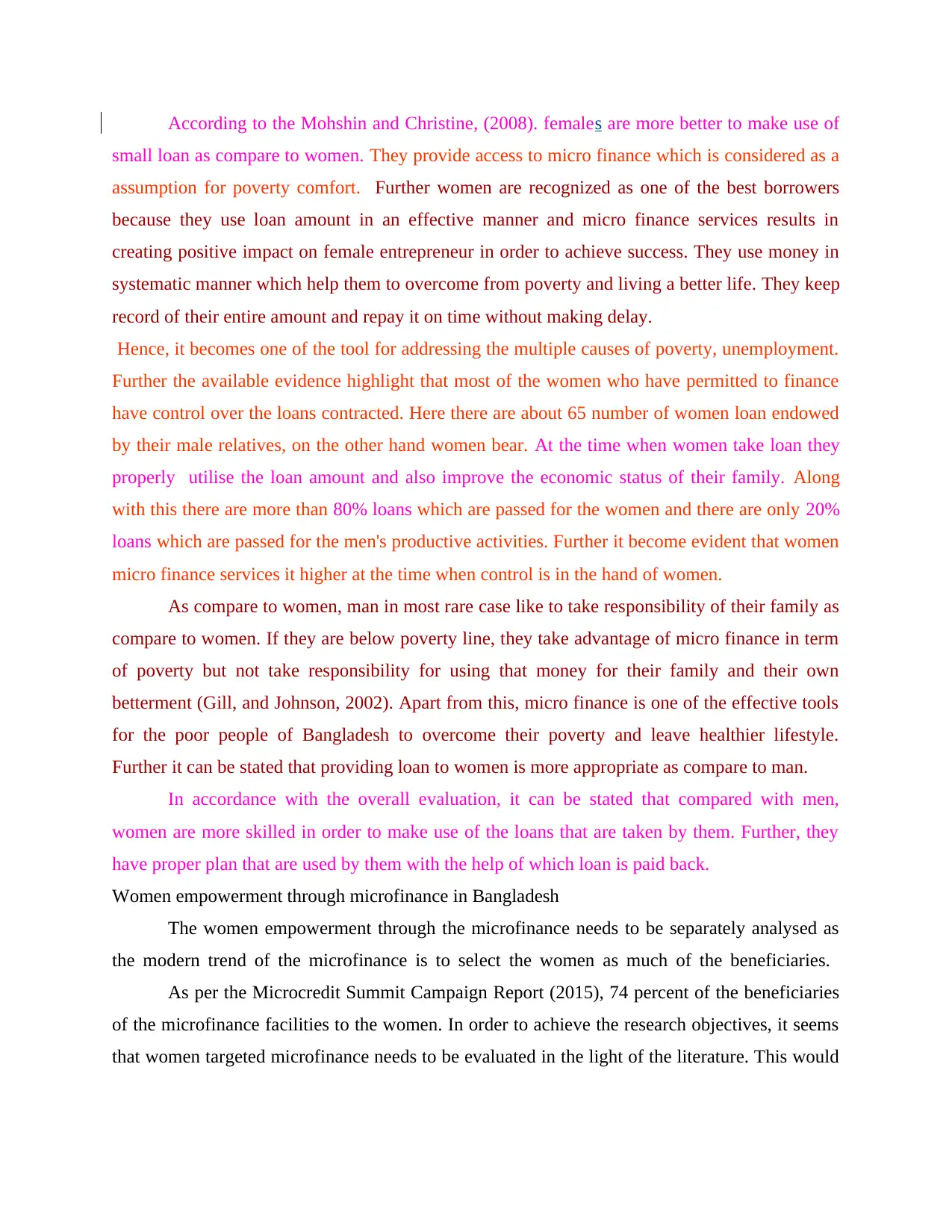
According to the Mohshin and Christine, (2008). females are more better to make use of
small loan as compare to women. They provide access to micro finance which is considered as a
assumption for poverty comfort. Further women are recognized as one of the best borrowers
because they use loan amount in an effective manner and micro finance services results in
creating positive impact on female entrepreneur in order to achieve success. They use money in
systematic manner which help them to overcome from poverty and living a better life. They keep
record of their entire amount and repay it on time without making delay.
Hence, it becomes one of the tool for addressing the multiple causes of poverty, unemployment.
Further the available evidence highlight that most of the women who have permitted to finance
have control over the loans contracted. Here there are about 65 number of women loan endowed
by their male relatives, on the other hand women bear. At the time when women take loan they
properly utilise the loan amount and also improve the economic status of their family. Along
with this there are more than 80% loans which are passed for the women and there are only 20%
loans which are passed for the men's productive activities. Further it become evident that women
micro finance services it higher at the time when control is in the hand of women.
As compare to women, man in most rare case like to take responsibility of their family as
compare to women. If they are below poverty line, they take advantage of micro finance in term
of poverty but not take responsibility for using that money for their family and their own
betterment (Gill, and Johnson, 2002). Apart from this, micro finance is one of the effective tools
for the poor people of Bangladesh to overcome their poverty and leave healthier lifestyle.
Further it can be stated that providing loan to women is more appropriate as compare to man.
In accordance with the overall evaluation, it can be stated that compared with men,
women are more skilled in order to make use of the loans that are taken by them. Further, they
have proper plan that are used by them with the help of which loan is paid back.
Women empowerment through microfinance in Bangladesh
The women empowerment through the microfinance needs to be separately analysed as
the modern trend of the microfinance is to select the women as much of the beneficiaries.
As per the Microcredit Summit Campaign Report (2015), 74 percent of the beneficiaries
of the microfinance facilities to the women. In order to achieve the research objectives, it seems
that women targeted microfinance needs to be evaluated in the light of the literature. This would
small loan as compare to women. They provide access to micro finance which is considered as a
assumption for poverty comfort. Further women are recognized as one of the best borrowers
because they use loan amount in an effective manner and micro finance services results in
creating positive impact on female entrepreneur in order to achieve success. They use money in
systematic manner which help them to overcome from poverty and living a better life. They keep
record of their entire amount and repay it on time without making delay.
Hence, it becomes one of the tool for addressing the multiple causes of poverty, unemployment.
Further the available evidence highlight that most of the women who have permitted to finance
have control over the loans contracted. Here there are about 65 number of women loan endowed
by their male relatives, on the other hand women bear. At the time when women take loan they
properly utilise the loan amount and also improve the economic status of their family. Along
with this there are more than 80% loans which are passed for the women and there are only 20%
loans which are passed for the men's productive activities. Further it become evident that women
micro finance services it higher at the time when control is in the hand of women.
As compare to women, man in most rare case like to take responsibility of their family as
compare to women. If they are below poverty line, they take advantage of micro finance in term
of poverty but not take responsibility for using that money for their family and their own
betterment (Gill, and Johnson, 2002). Apart from this, micro finance is one of the effective tools
for the poor people of Bangladesh to overcome their poverty and leave healthier lifestyle.
Further it can be stated that providing loan to women is more appropriate as compare to man.
In accordance with the overall evaluation, it can be stated that compared with men,
women are more skilled in order to make use of the loans that are taken by them. Further, they
have proper plan that are used by them with the help of which loan is paid back.
Women empowerment through microfinance in Bangladesh
The women empowerment through the microfinance needs to be separately analysed as
the modern trend of the microfinance is to select the women as much of the beneficiaries.
As per the Microcredit Summit Campaign Report (2015), 74 percent of the beneficiaries
of the microfinance facilities to the women. In order to achieve the research objectives, it seems
that women targeted microfinance needs to be evaluated in the light of the literature. This would
Paraphrase This Document
Need a fresh take? Get an instant paraphrase of this document with our AI Paraphraser
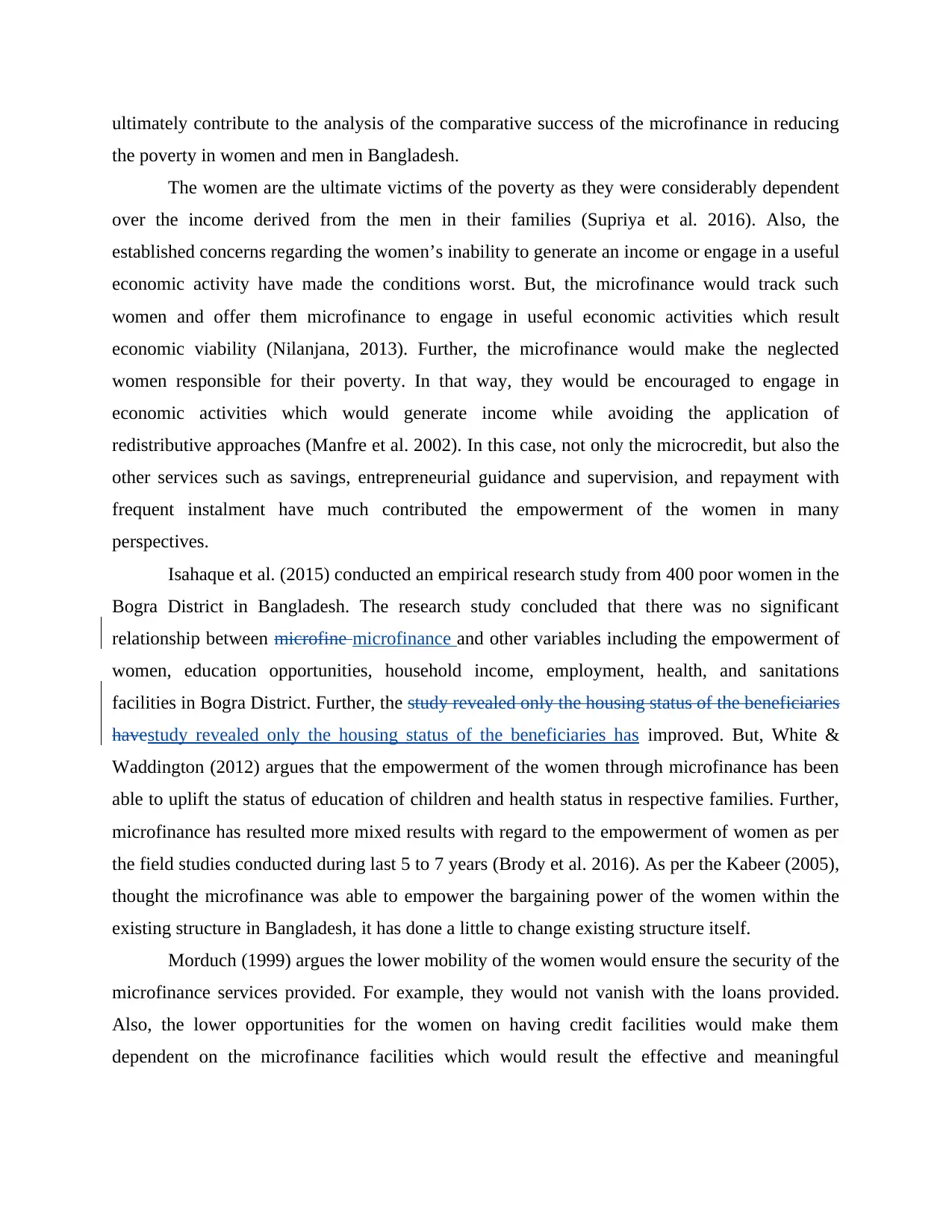
ultimately contribute to the analysis of the comparative success of the microfinance in reducing
the poverty in women and men in Bangladesh.
The women are the ultimate victims of the poverty as they were considerably dependent
over the income derived from the men in their families (Supriya et al. 2016). Also, the
established concerns regarding the women’s inability to generate an income or engage in a useful
economic activity have made the conditions worst. But, the microfinance would track such
women and offer them microfinance to engage in useful economic activities which result
economic viability (Nilanjana, 2013). Further, the microfinance would make the neglected
women responsible for their poverty. In that way, they would be encouraged to engage in
economic activities which would generate income while avoiding the application of
redistributive approaches (Manfre et al. 2002). In this case, not only the microcredit, but also the
other services such as savings, entrepreneurial guidance and supervision, and repayment with
frequent instalment have much contributed the empowerment of the women in many
perspectives.
Isahaque et al. (2015) conducted an empirical research study from 400 poor women in the
Bogra District in Bangladesh. The research study concluded that there was no significant
relationship between microfine microfinance and other variables including the empowerment of
women, education opportunities, household income, employment, health, and sanitations
facilities in Bogra District. Further, the study revealed only the housing status of the beneficiaries
havestudy revealed only the housing status of the beneficiaries has improved. But, White &
Waddington (2012) argues that the empowerment of the women through microfinance has been
able to uplift the status of education of children and health status in respective families. Further,
microfinance has resulted more mixed results with regard to the empowerment of women as per
the field studies conducted during last 5 to 7 years (Brody et al. 2016). As per the Kabeer (2005),
thought the microfinance was able to empower the bargaining power of the women within the
existing structure in Bangladesh, it has done a little to change existing structure itself.
Morduch (1999) argues the lower mobility of the women would ensure the security of the
microfinance services provided. For example, they would not vanish with the loans provided.
Also, the lower opportunities for the women on having credit facilities would make them
dependent on the microfinance facilities which would result the effective and meaningful
the poverty in women and men in Bangladesh.
The women are the ultimate victims of the poverty as they were considerably dependent
over the income derived from the men in their families (Supriya et al. 2016). Also, the
established concerns regarding the women’s inability to generate an income or engage in a useful
economic activity have made the conditions worst. But, the microfinance would track such
women and offer them microfinance to engage in useful economic activities which result
economic viability (Nilanjana, 2013). Further, the microfinance would make the neglected
women responsible for their poverty. In that way, they would be encouraged to engage in
economic activities which would generate income while avoiding the application of
redistributive approaches (Manfre et al. 2002). In this case, not only the microcredit, but also the
other services such as savings, entrepreneurial guidance and supervision, and repayment with
frequent instalment have much contributed the empowerment of the women in many
perspectives.
Isahaque et al. (2015) conducted an empirical research study from 400 poor women in the
Bogra District in Bangladesh. The research study concluded that there was no significant
relationship between microfine microfinance and other variables including the empowerment of
women, education opportunities, household income, employment, health, and sanitations
facilities in Bogra District. Further, the study revealed only the housing status of the beneficiaries
havestudy revealed only the housing status of the beneficiaries has improved. But, White &
Waddington (2012) argues that the empowerment of the women through microfinance has been
able to uplift the status of education of children and health status in respective families. Further,
microfinance has resulted more mixed results with regard to the empowerment of women as per
the field studies conducted during last 5 to 7 years (Brody et al. 2016). As per the Kabeer (2005),
thought the microfinance was able to empower the bargaining power of the women within the
existing structure in Bangladesh, it has done a little to change existing structure itself.
Morduch (1999) argues the lower mobility of the women would ensure the security of the
microfinance services provided. For example, they would not vanish with the loans provided.
Also, the lower opportunities for the women on having credit facilities would make them
dependent on the microfinance facilities which would result the effective and meaningful
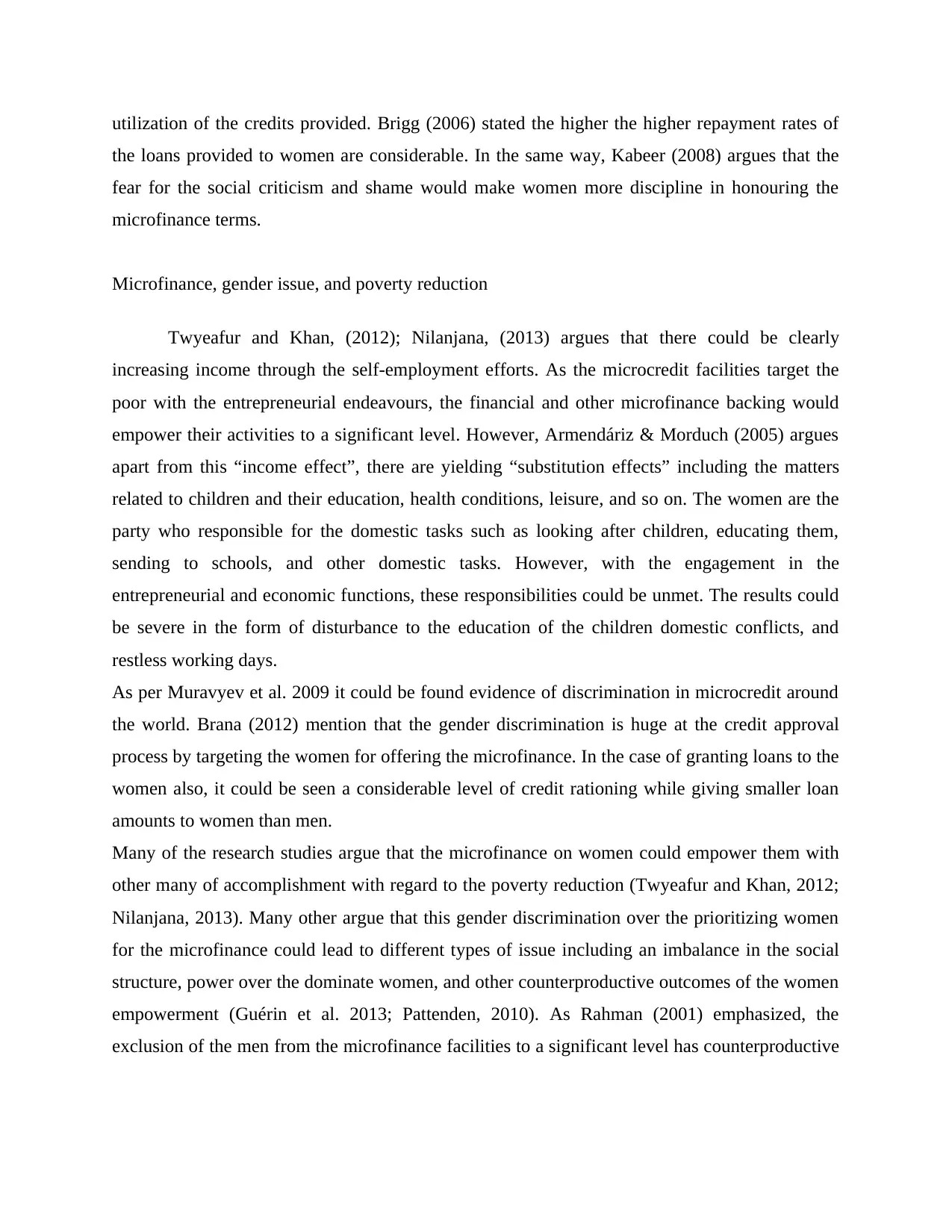
utilization of the credits provided. Brigg (2006) stated the higher the higher repayment rates of
the loans provided to women are considerable. In the same way, Kabeer (2008) argues that the
fear for the social criticism and shame would make women more discipline in honouring the
microfinance terms.
Microfinance, gender issue, and poverty reduction
Twyeafur and Khan, (2012); Nilanjana, (2013) argues that there could be clearly
increasing income through the self-employment efforts. As the microcredit facilities target the
poor with the entrepreneurial endeavours, the financial and other microfinance backing would
empower their activities to a significant level. However, Armendáriz & Morduch (2005) argues
apart from this “income effect”, there are yielding “substitution effects” including the matters
related to children and their education, health conditions, leisure, and so on. The women are the
party who responsible for the domestic tasks such as looking after children, educating them,
sending to schools, and other domestic tasks. However, with the engagement in the
entrepreneurial and economic functions, these responsibilities could be unmet. The results could
be severe in the form of disturbance to the education of the children domestic conflicts, and
restless working days.
As per Muravyev et al. 2009 it could be found evidence of discrimination in microcredit around
the world. Brana (2012) mention that the gender discrimination is huge at the credit approval
process by targeting the women for offering the microfinance. In the case of granting loans to the
women also, it could be seen a considerable level of credit rationing while giving smaller loan
amounts to women than men.
Many of the research studies argue that the microfinance on women could empower them with
other many of accomplishment with regard to the poverty reduction (Twyeafur and Khan, 2012;
Nilanjana, 2013). Many other argue that this gender discrimination over the prioritizing women
for the microfinance could lead to different types of issue including an imbalance in the social
structure, power over the dominate women, and other counterproductive outcomes of the women
empowerment (Guérin et al. 2013; Pattenden, 2010). As Rahman (2001) emphasized, the
exclusion of the men from the microfinance facilities to a significant level has counterproductive
the loans provided to women are considerable. In the same way, Kabeer (2008) argues that the
fear for the social criticism and shame would make women more discipline in honouring the
microfinance terms.
Microfinance, gender issue, and poverty reduction
Twyeafur and Khan, (2012); Nilanjana, (2013) argues that there could be clearly
increasing income through the self-employment efforts. As the microcredit facilities target the
poor with the entrepreneurial endeavours, the financial and other microfinance backing would
empower their activities to a significant level. However, Armendáriz & Morduch (2005) argues
apart from this “income effect”, there are yielding “substitution effects” including the matters
related to children and their education, health conditions, leisure, and so on. The women are the
party who responsible for the domestic tasks such as looking after children, educating them,
sending to schools, and other domestic tasks. However, with the engagement in the
entrepreneurial and economic functions, these responsibilities could be unmet. The results could
be severe in the form of disturbance to the education of the children domestic conflicts, and
restless working days.
As per Muravyev et al. 2009 it could be found evidence of discrimination in microcredit around
the world. Brana (2012) mention that the gender discrimination is huge at the credit approval
process by targeting the women for offering the microfinance. In the case of granting loans to the
women also, it could be seen a considerable level of credit rationing while giving smaller loan
amounts to women than men.
Many of the research studies argue that the microfinance on women could empower them with
other many of accomplishment with regard to the poverty reduction (Twyeafur and Khan, 2012;
Nilanjana, 2013). Many other argue that this gender discrimination over the prioritizing women
for the microfinance could lead to different types of issue including an imbalance in the social
structure, power over the dominate women, and other counterproductive outcomes of the women
empowerment (Guérin et al. 2013; Pattenden, 2010). As Rahman (2001) emphasized, the
exclusion of the men from the microfinance facilities to a significant level has counterproductive
⊘ This is a preview!⊘
Do you want full access?
Subscribe today to unlock all pages.

Trusted by 1+ million students worldwide
1 out of 26
Your All-in-One AI-Powered Toolkit for Academic Success.
+13062052269
info@desklib.com
Available 24*7 on WhatsApp / Email
![[object Object]](/_next/static/media/star-bottom.7253800d.svg)
Unlock your academic potential
Copyright © 2020–2025 A2Z Services. All Rights Reserved. Developed and managed by ZUCOL.
